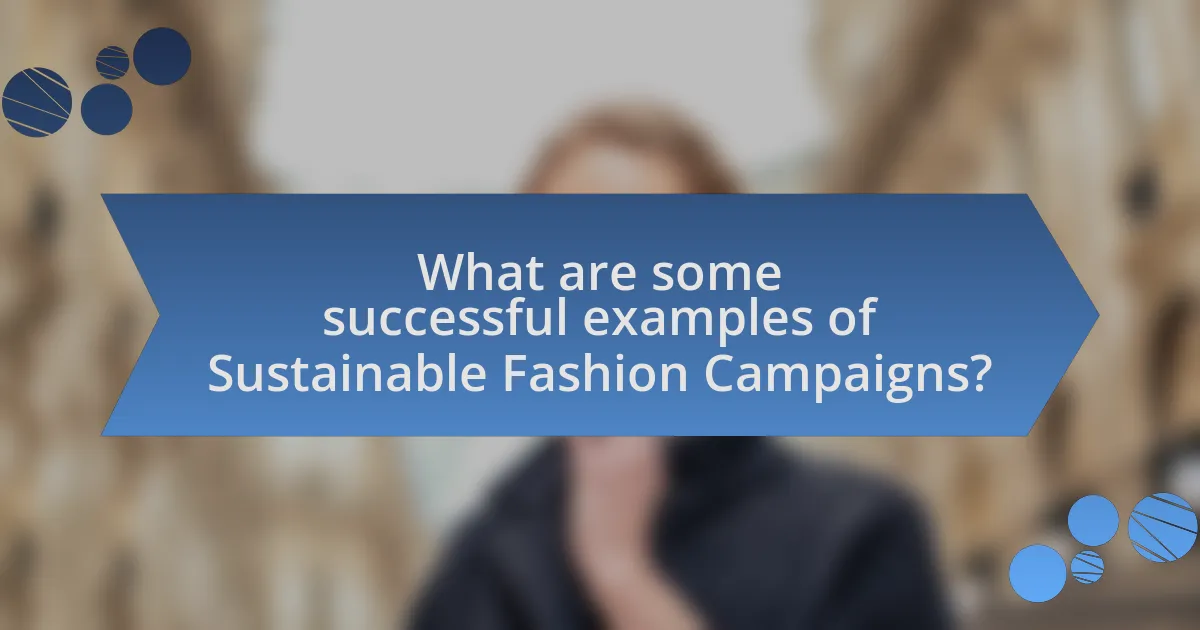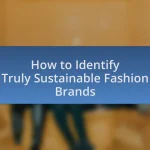Sustainable fashion campaigns are initiatives designed to promote environmentally friendly practices within the fashion industry, focusing on ethical production methods and consumer awareness. These campaigns differ from traditional fashion marketing by prioritizing social responsibility over consumerism, advocating for transparency in supply chains and the use of eco-friendly materials. Key principles guiding these campaigns include environmental responsibility, ethical labor practices, and transparency, which collectively aim to mitigate the negative impacts of fast fashion. Successful examples, such as Patagonia’s “Don’t Buy This Jacket” and the Fashion Revolution campaign, illustrate effective strategies in raising awareness and influencing consumer behavior, while also highlighting the importance of collaboration and transparency in achieving sustainability goals. The article will explore the impact of these campaigns on industry standards, consumer behavior, and the lessons learned for future initiatives.

What are Sustainable Fashion Campaigns?
Sustainable fashion campaigns are initiatives aimed at promoting environmentally friendly practices within the fashion industry. These campaigns often focus on raising awareness about the negative impacts of fast fashion, advocating for ethical production methods, and encouraging consumers to make more sustainable choices, such as purchasing second-hand clothing or supporting brands that prioritize sustainability. For instance, the Fashion Revolution campaign, which began in 2013, emphasizes transparency in the supply chain and has mobilized millions globally to demand better practices from fashion brands.
How do Sustainable Fashion Campaigns differ from traditional fashion marketing?
Sustainable fashion campaigns differ from traditional fashion marketing primarily in their focus on environmental and social responsibility rather than solely on consumerism and trends. Traditional fashion marketing often emphasizes fast fashion, promoting frequent purchases and disposable clothing, which contributes to environmental degradation. In contrast, sustainable fashion campaigns advocate for ethical production practices, transparency in supply chains, and the use of eco-friendly materials, aiming to educate consumers about the impact of their choices. For instance, brands like Patagonia and Everlane highlight their commitment to sustainability through initiatives such as fair labor practices and reducing carbon footprints, which resonate with a growing consumer base that prioritizes ethical consumption. This shift is supported by research indicating that 66% of global consumers are willing to pay more for sustainable brands, demonstrating a significant market demand for responsible fashion practices.
What principles guide Sustainable Fashion Campaigns?
Sustainable Fashion Campaigns are guided by principles such as environmental responsibility, ethical labor practices, and transparency. Environmental responsibility emphasizes reducing waste and utilizing eco-friendly materials, which is supported by the fact that the fashion industry is responsible for 10% of global carbon emissions. Ethical labor practices focus on fair wages and safe working conditions, as highlighted by the 2018 Ethical Fashion Report, which shows that brands adhering to these practices improve worker welfare. Transparency involves clear communication about sourcing and production processes, which builds consumer trust and accountability, as evidenced by the rise of brands that disclose their supply chains. These principles collectively aim to create a more sustainable and equitable fashion industry.
How do these campaigns address environmental and social issues?
Sustainable fashion campaigns address environmental and social issues by promoting eco-friendly practices and advocating for fair labor conditions. These campaigns often highlight the negative impacts of fast fashion, such as pollution and exploitation of workers, and encourage consumers to choose sustainable brands that prioritize ethical sourcing and production methods. For instance, the Fashion Revolution campaign raises awareness about the fashion industry’s transparency and calls for brands to disclose their supply chains, thereby fostering accountability and encouraging sustainable practices. Additionally, campaigns like the Ellen MacArthur Foundation’s “Make Fashion Circular” initiative focus on circular economy principles, aiming to reduce waste and promote recycling in the fashion industry. These efforts collectively contribute to mitigating environmental harm and improving social equity within the fashion sector.
Why are Sustainable Fashion Campaigns important in today’s market?
Sustainable fashion campaigns are important in today’s market because they address the growing consumer demand for environmentally and socially responsible products. As awareness of the negative impacts of fast fashion increases, campaigns that promote sustainability help brands differentiate themselves and attract eco-conscious consumers. For instance, a 2021 survey by McKinsey & Company found that 67% of consumers consider the use of sustainable materials to be an important factor in their purchasing decisions. This shift not only influences consumer behavior but also encourages brands to adopt more sustainable practices, ultimately leading to a positive impact on the environment and society.
What impact do they have on consumer behavior?
Sustainable fashion campaigns significantly influence consumer behavior by increasing awareness and promoting eco-friendly purchasing decisions. These campaigns often highlight the environmental and social impacts of fashion, leading consumers to prefer brands that prioritize sustainability. For instance, a study by Nielsen found that 66% of global consumers are willing to pay more for sustainable brands, demonstrating a clear shift towards environmentally conscious buying habits. Additionally, campaigns that effectively communicate their sustainability efforts can enhance brand loyalty, as consumers increasingly seek to align their values with their purchasing choices.
How do they influence industry standards and practices?
Sustainable fashion campaigns influence industry standards and practices by promoting eco-friendly materials, ethical labor practices, and transparency in supply chains. These campaigns often set benchmarks that brands strive to meet, leading to widespread adoption of sustainable practices across the industry. For instance, the Fashion Revolution campaign, which began in response to the Rana Plaza disaster, has significantly raised awareness about garment workers’ rights and environmental impacts, prompting brands to adopt more responsible sourcing and production methods. This shift is evidenced by the increasing number of brands committing to sustainability initiatives, as reported in the 2021 Global Fashion Agenda’s Pulse of the Fashion Industry report, which highlights a growing trend towards circular fashion and reduced carbon footprints.

What are some successful examples of Sustainable Fashion Campaigns?
Some successful examples of sustainable fashion campaigns include Patagonia’s “Don’t Buy This Jacket” campaign, which encouraged consumers to reconsider their purchasing habits and promoted repair and reuse. This campaign resulted in increased sales while also raising awareness about environmental impact. Another notable example is H&M’s “Conscious Collection,” which features garments made from sustainable materials and has significantly contributed to the brand’s sustainability narrative, leading to a reported 35% increase in sales for the collection. Additionally, the “Fashion Revolution” campaign, initiated after the Rana Plaza disaster, has successfully mobilized consumers to demand transparency in the fashion supply chain, resulting in over 100 brands committing to greater accountability. These campaigns demonstrate effective strategies in promoting sustainability while achieving business objectives.
How did these campaigns achieve their goals?
Sustainable fashion campaigns achieved their goals by effectively raising awareness, engaging consumers, and promoting eco-friendly practices. For instance, campaigns like Fashion Revolution utilized social media to educate the public about the impacts of fast fashion, leading to increased consumer demand for transparency and ethical production. Additionally, initiatives such as the Ellen MacArthur Foundation’s “Make Fashion Circular” encouraged brands to adopt circular economy principles, resulting in significant commitments from major fashion retailers to reduce waste and enhance sustainability. These strategies were supported by measurable outcomes, such as increased sales of sustainable products and pledges from brands to implement sustainable practices, demonstrating the campaigns’ effectiveness in driving change within the industry.
What strategies were employed in these successful campaigns?
Successful sustainable fashion campaigns employed strategies such as storytelling, community engagement, and transparency. Storytelling effectively communicated the brand’s values and mission, resonating with consumers who prioritize ethical practices. Community engagement involved collaborating with influencers and local organizations to amplify the campaign’s reach and foster a sense of belonging among consumers. Transparency in sourcing and production processes built trust, as brands openly shared their sustainability efforts and challenges. For instance, brands like Patagonia have successfully utilized these strategies, leading to increased consumer loyalty and sales, as evidenced by their reported growth in revenue and customer base.
What role did collaboration play in their success?
Collaboration was essential to the success of sustainable fashion campaigns, as it enabled diverse stakeholders to combine resources, expertise, and networks. For instance, partnerships between brands, NGOs, and local communities facilitated innovative solutions and broader outreach, amplifying the impact of sustainability initiatives. Research indicates that collaborative efforts in sustainable fashion can lead to increased consumer awareness and engagement, ultimately driving sales and brand loyalty. A notable example is the collaboration between Stella McCartney and various environmental organizations, which not only enhanced brand credibility but also educated consumers on sustainable practices, demonstrating the tangible benefits of working together in the industry.
What lessons can be learned from these success stories?
Success stories in sustainable fashion campaigns demonstrate the importance of consumer engagement and transparency. These campaigns show that actively involving consumers in sustainability efforts leads to increased brand loyalty and awareness. For instance, brands like Patagonia have successfully engaged customers by promoting environmental activism, resulting in a 30% increase in sales during their “Don’t Buy This Jacket” campaign, which encouraged responsible consumption. Additionally, transparency in sourcing and production processes fosters trust; brands that openly share their supply chain practices often see a positive response from consumers, as evidenced by the rise of brands like Everlane, which emphasizes “radical transparency.” These lessons highlight that effective communication and consumer involvement are crucial for success in sustainable fashion initiatives.
What common challenges did these campaigns face?
Sustainable fashion campaigns commonly faced challenges such as consumer awareness, supply chain transparency, and financial sustainability. Consumer awareness was often low, making it difficult for campaigns to engage the target audience effectively. For instance, a study by the Global Fashion Agenda indicated that only 30% of consumers are aware of the environmental impact of their clothing choices. Supply chain transparency posed another significant challenge, as many brands struggled to trace the origins of their materials, leading to skepticism among consumers regarding claims of sustainability. Additionally, financial sustainability was a critical issue, with many campaigns lacking the necessary funding to scale their initiatives, as highlighted by the Fashion for Good report, which noted that only 10% of sustainable fashion startups secure adequate investment.
How did they overcome obstacles to achieve success?
Sustainable fashion campaigns overcame obstacles to achieve success by leveraging innovative strategies and community engagement. For instance, brands like Patagonia and Stella McCartney faced challenges such as consumer skepticism and high production costs. They addressed these issues by educating consumers on the environmental impact of fast fashion and promoting transparency in their supply chains. Patagonia’s “Don’t Buy This Jacket” campaign effectively encouraged responsible consumption, leading to increased brand loyalty and sales. Additionally, Stella McCartney’s commitment to cruelty-free materials and sustainable practices resonated with eco-conscious consumers, resulting in a strong market presence. These approaches demonstrate that addressing consumer concerns and fostering a sense of community can effectively overcome barriers in the sustainable fashion industry.

What are the key takeaways for future Sustainable Fashion Campaigns?
Key takeaways for future Sustainable Fashion Campaigns include prioritizing transparency, engaging consumers through storytelling, and leveraging collaborations with sustainable brands. Transparency builds trust; for instance, brands that disclose their supply chain practices see increased consumer loyalty. Engaging storytelling resonates with consumers, as campaigns that highlight the journey of sustainable products can enhance emotional connections, leading to higher engagement rates. Collaborations with established sustainable brands can amplify reach and credibility, as seen in partnerships like Stella McCartney with Adidas, which successfully merged fashion with sustainability. These strategies are essential for driving awareness and fostering a culture of sustainability in the fashion industry.
What best practices should be adopted?
Best practices for sustainable fashion campaigns include transparency in sourcing materials, engaging consumers through storytelling, and collaborating with eco-conscious influencers. Transparency fosters trust, as consumers increasingly prefer brands that disclose their supply chain practices; for instance, brands like Patagonia openly share their sourcing and manufacturing processes. Engaging storytelling connects emotionally with consumers, making them more likely to support sustainable initiatives; studies show that narratives can increase consumer engagement by up to 30%. Collaborating with influencers who prioritize sustainability amplifies the campaign’s reach and credibility, as seen in successful partnerships like H&M’s Conscious Collection with eco-influencers. These practices collectively enhance brand loyalty and promote sustainable consumer behavior.
How can brands effectively communicate their sustainability efforts?
Brands can effectively communicate their sustainability efforts by utilizing transparent messaging, engaging storytelling, and leveraging multiple platforms for outreach. Transparency involves providing clear, verifiable information about sustainable practices, such as sourcing materials or reducing carbon footprints, which builds trust with consumers. Engaging storytelling allows brands to connect emotionally with their audience, showcasing real-life impacts of their sustainability initiatives, such as community benefits or environmental improvements. Additionally, using various platforms—social media, websites, and partnerships with sustainability influencers—ensures broader reach and engagement. According to a 2021 Nielsen report, 73% of consumers are willing to change their consumption habits to reduce environmental impact, highlighting the importance of effective communication in influencing consumer behavior.
What metrics should be used to measure campaign success?
To measure campaign success in sustainable fashion, key metrics include engagement rate, conversion rate, return on investment (ROI), and brand awareness. Engagement rate assesses how well the audience interacts with the campaign, typically measured through likes, shares, and comments on social media platforms. Conversion rate indicates the percentage of users who take a desired action, such as making a purchase or signing up for a newsletter, reflecting the campaign’s effectiveness in driving sales or leads. ROI quantifies the financial return relative to the campaign’s cost, providing insight into its profitability. Brand awareness can be measured through surveys or social media reach, indicating how well the campaign has increased recognition of the sustainable fashion brand. These metrics collectively provide a comprehensive view of a campaign’s performance and impact.
What practical tips can brands implement for their own Sustainable Fashion Campaigns?
Brands can implement several practical tips for their Sustainable Fashion Campaigns, including using eco-friendly materials, promoting transparency in supply chains, and engaging consumers through education. Utilizing organic cotton or recycled fabrics reduces environmental impact, as these materials require less water and energy compared to conventional options. Transparency in supply chains builds consumer trust; brands like Patagonia have demonstrated that sharing sourcing practices can enhance brand loyalty. Engaging consumers through educational content about sustainability fosters a community around the brand, as seen in campaigns by Everlane, which emphasize ethical production. These strategies not only align with sustainability goals but also resonate with the growing consumer demand for responsible fashion.















